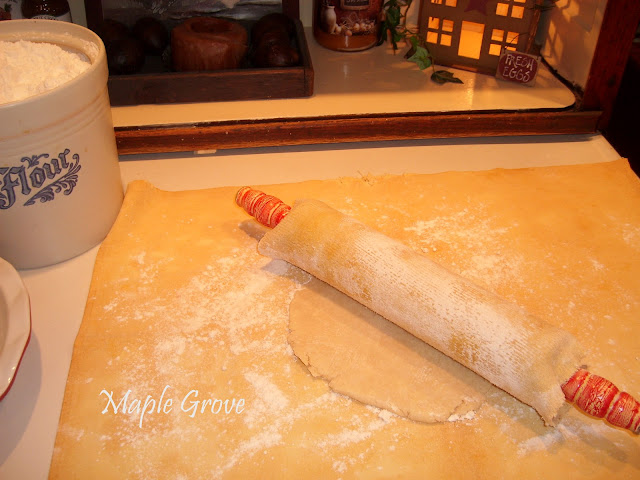When I got married, my first few attempts at making pies didn't turn out very good. So I asked my Mom to teach me. Mom gave me her recipe and her tips as she demonstrated her art. I learned quickly, and from then on people raved about my pies, especially the flaky crusts.
Nowadays, it is so easy to use the refrigerator pie crusts that you can buy in a grocery store. I guess they're OK in a pinch if you're in a major hurry. But, truth be told, they are just not the same as old-fashioned, homemade pie crusts. Unless time is of the utmost essence, there is really no need to forgo this timeless treasure--not when you have the right recipe and know-how. So I gladly share with you lessons I learned at my Mom's side.
Mom's Old-Fashioned Pie Crust Recipe
4 C. flour, unsifted
2 T. sugar
1 t. salt
1 3/4 C. shortening
1 large egg
1/2 C. cold water
1 T. white or cider vinegar
This recipe makes 5 pie crusts. I know it's a weird number. I usually use it to make two two-crust pies and one single-crust pie, or I just use the extra crust to make a couple of dumplings. For a two-crust pie, cut the recipe in half, but you won't need all of the dough. The unbaked dough can be frozen for up to six weeks. Remove from the freezer an hour before using.
In a large bowl, mix the first three ingredients well with a fork.
Add shortening and mix well with a fork or pastry blender until crumbly.
In a small bowl, beat the egg with the water and vinegar.
Combine the two mixtures, stirring until well moistened.
Divide into five parts. Shape each into a round flat. Wrap in wax paper and chill at least 1/2 hour.
Step-by-Step Directions and Tips for Perfect Flaky Pie Crust
Here is the big secret to flaky pie crust: DON'T TOUCH the dough with your hands at all and KEEP IT COOL. Also, don't over-mix the ingredients. The dough should be crumbly, not kneaded smooth.
Gather all of your ingredients and utensils in your baking area. If it is a warm day, you may want to place your mixing bowl in the refrigerator for several minutes.
In a large bowl, stir together the flour, sugar and salt.
Add shortening and cut in with a fork or pastry blender until the mixture is crumbly.
 |
Combine the two mixtures, stirring with a fork until evenly moistened. The dough will still be quite crumbly.
Lay five pieces of wax paper onto the table surface. Using a one-cup dry measuring cup as a scoop, divide the dough into five parts.
Notice how crumbly the mixture is.
Loosely fold the corners of the wax paper over the mound of dough and press it down into a flattened round. (When you fold the ends over, leave plenty of space for the mound to expand when you press it.)
Flip the wrapped dough over to hold the ends down and refrigerate the dough for at least 1/2 hour.
Take a mound of the refrigerated dough and lay it on a smooth surface. A floured pastry cloth and rolling pin cover make it super easy to roll out the dough. (I love that I have my Grandma's rolling pin that both she and my Mom used to make mouth-watering pies.)
Press the rolling pin down on the center of the mound and begin rolling from the center toward the outside edges, shaping the dough into a thin round.
The dough should easily stretch out on the cloth. If it begins to stick or not move easily, lift the corner of the cloth, flopping the dough over the rolling pin and lifting it up off the cloth. Sprinkle more flour on the pastry cloth and turn the dough over. Rub more flour onto the rolling pin cover.
Continue to roll the dough until it is about an inch larger than the outside rim of your pie pan. Lift the corner of the pastry cloth, rolling the dough onto the rolling pin and transfer it to the pie pan.
Use a knife to trim the excess dough away at the edge of the pie pan rim.
Pour your pie filling into the pastry-lined pan and dot with pats of butter if the recipe calls for it.
Roll out the second pastry and transfer it with the rolling pin to cover the pie filling. Trim away the excess dough about an inch beyond the edge of the pie pan.
Fold the edge of the top pastry under, tucking in the edge of the bottom pastry. Use your thumb and the second knuckle of your index finger to pinch around the edge of the pie pastry. (Now, I am 100% serious about this: until this point, my hands have not touched this pie dough. I really believe this is the biggest secret to flaky crust. It was loosely mixed with a fork and then the crumbs were pressed together with the rolling pin.)
Use a sharp knife to cut slits in the top of the pastry to allow steam to escape when baking.
Wrap the edges of the pie crust with foil until the last ten minutes of baking to prevent it from burning.
Wait until you see the flakiness of this pie crust!
And just wait until your family and friends see and taste your perfect old-fashioned pies!
Happy old-fashioned eating!
For a baked pie shell: Preheat oven to 475*, prepare the crust in a pie pan, prick the bottom and sides with a fork, and bake for 8-10 minutes.
Click here for my Mom's Old-Fashion Apple Pie recipe.
 |
| My Mom and me. |
If you would like to print out this recipe, click on the print friendly box below. When the window opens, you can click on the box at the top to remove images.



















